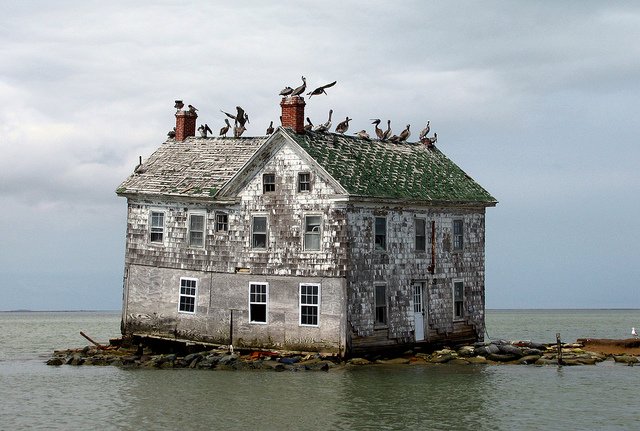#FBF! We’re flashing wayyyy back to the 1600’s, when Maryland was home to a piece of land in the Chesapeake Bay known to locals as Holland Island. After seeing an article recently that showcased a home on Holland Island as one of 34 isolated homes in the world, we thought we would do a little digging to find out about the house and the tiny Bay island.
Holland Island was named after the first owner of the property, Daniel Holland, who was a colonist. For the next two hundred years, life on Holland Island would sail along quietly and smoothly. Not surprisingly, in 1850 fishing and farming boomed, bringing many looking for work to the small island. Just by 1890 watermen from all over the state came to build up the community and by 1910 the island would house nearly 360 residents. Holland Island was thriving, thus, making it the most populated island in the Chesapeake Bay. 90 ships would port at Holland Island, catching fish, oysters and crabs. It housed nearly 70 structures that included everything from houses and a school to a doctor’s office, a post office, a church, a baseball team and a community center.
Unfortunately for Holland Island, their homes were built on mud and silt rather than rock… which made the land more susceptible to shoreline erosion. By 1914, Holland Island was visibly losing their shoreline. All attempts to stop the erosion failed, leaving the residents forced to head back to the mainland. The last standing family stayed until 1918, when a tropical storm damaged the island’s church, although some fishermen hung in there until finally everyone left in 1922. (Most of them moved to Crisfield.)
73 years went by before Holland Island was touched again, this time by someone who grew up there almost 50 years earlier. Stephen White, a Maryland minister purchased the island for $70,000 to try and preserve the legacy and the childhood he remembered. After many efforts to save the island, White had no success. He tried excavating machines, bulldozers, replacing levees and sunken barges and nothing worked. White spent an estimated $150,000 to save his beloved island but realized the island had only shrunk during his years of ownership. The state decided trying to save the island would be a waste of money, so nothing more was done to preserve it. In the 90 year period from 1915 to 2005, the island saw its size cut in half from 160 acres to 80. What was once a 5-mile long island has been reduced to a swampy marsh that sits underwater at high tide. The only inhabitants are birds, and by 2003, Hurricane Isabel destroyed most of the remaining vegetation.
2010 came along; the final remaining Victorian house would eventually collapse into the bay, and by 2011 Holland Island was gone… with it all its history.









